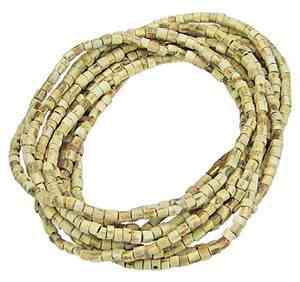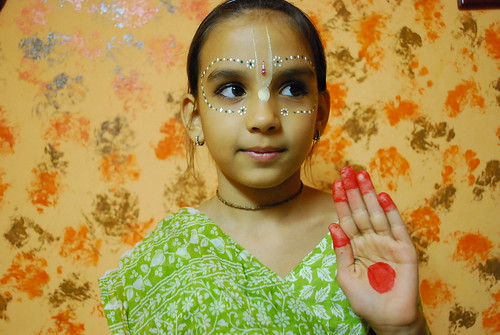
A few weeks ago I posted an article about Tilaka. In this article Srila Prabhupada was quoted saying,
“I have no objection if members of the Society dress like nice American gentlemen; but in all circumstances a devotee cannot avoid tilaka, flag on head (shikha) and (tulasi) beads on the neck. These are the essential features of a Vaisnava." (SPL to Brahmananda, 14th October, 1967)Tulsi Kanthi in on this list so I thought that I should also share some info about the kanthi, neckbeads as well.
The Krishna conscious culture teaches that anyone who is an aspiring devotee of Krishna should wear Tulasi neckbeads for Tulasi is so spiritually potent. The following are some verses from the Hari Bhakti Vilasa
pūjayet punyam āpnoti pratipuspam gavāyutam ||326||
One who engages in the worship of Śrī Janārdana while wearing tulasī neckbeads accumulates piety equivalent to giving ten thousand cows in charity for each of his flower offerings.
phalam yacchati daitārih pratyaham dvārakodbhavam ||332||
A person who wears tulasī neckbeads all the time obtains the result of living in Dvārakā.
sadā prītamanās tasya krsna devakī-nandanah |
tulasī-kāstha-sambhūtām yo mālām vahate narah |
prāyaścittam na tasyāsti nāśaucam tasya vigrahe ||334||
tulasī-kāstha-sambhūtām śiraso yasya bhūsanam |
bāhvoh kare ca martyasya dehe tasya sadā harih ||335||
There is no need to perform atonement for a person who wears tulasī neckbeads. Factually, he does not become contaminated at any stage in his life. Śrī Hari resides in the body of a person whose neck and arms are decorated with ornament made of tulasī.
drstvā naśyanti dūrena vātoddhūtam yathā dalam ||337||
tulasī-kāstha-mālābhir bhūsito bhramate yadi |
duhsvapnam durnimittam ca na bhayam śastrajam kvacit ||338||
Just by seeing the tulasī beads on a person’s neck, the Yamadūtas flee to a distant place. A person who wanders here and there after putting on tulasī neckbeads has nothing to fear from an accident, bad dreams, or weapons.

In response to a list of several question asked by disciple Vidya dasi, Srila Prabhupada repliesSrila Prabhupada also states,
In the Padma Purāna there is a statement describing how a Vaisnava should decorate his body with tilaka and beads: "Persons who put tulasī beads on the neck, who mark twelve places of their bodies as Visnu temples with Visnu's symbolic representations [the four items held in the four hands of Lord Visnu—conch, mace, disc and lotus], and who have visnu-tilaka on their foreheads, are to be understood as the devotees of Lord Visnu in this world. Their presence makes the world purified, and anywhere they remain, they make that place as good as Vaikuntha."
“1) Tulasi is one devotee who appears wherever there is devotion to Krsna. 2) Tulasis body is spiritual. 3) Yes, jewelry is all right. 4) If possible. 5) Tulasi leaves should be offered to the Deity.Answers to
1. Is each Tulasi a separate jiva soul or an expansion of one pure devotee?Srila Prabhupada has also said,
2. Where does her spirit soul go when she leaves this body?
3. (missing)
4. When tulasi is being cared for by householders in their homes, must two aratis still be offered?
5. When tulasi is being cared for by householders in their homes, may they use her leaves and manjaris on their home offerings or should they take them to the temple?
Because Tulasi kanthi is so important they are never taken off, but they can be replaced. Anyone who wears Tulasi neckbeads at the time of death is greatly benefited beyond imagination, therefore it is important to keep them on at all times. Tulasi also identifies one as a follower of Lord Chaitanya."Just as a pet dog has got a collar, similarly we are pet dogs of God. So we have got this collar. And Yamaraja, the Lord of Death will understand that he-the devotee-is God's dog; he should not be shot down."
Srila Bhaktivinoda Thakura sings in his Svīkara: Acceptance of Activities Favorable to Pure Devotion - Song 2 Verse 3
gaura-bhakata-priya-veśa dadhānā
tilaka-tulasī-mālā-śobhamānā
3) I will put on the garb that is dear to the devotees of Lord Gaura-sundara, including the twelve Vaisnava tilaka markings on my body and beautiful beads of tulasī wood around my neck.

Srila Bhaktivinoda Thakur also writes in his Jaiva Dharma that of the 64 angas of devotional service the remaining fourty-four are observed to increase one’s bhakti. Item number one is decoration of the body with the Vaisnava signs of tilaka and tulasī beads.
Q. One may ask that if we are not the body then what is the need of instructions of decoration of the body?
A. Yes we are not the body but unless were are Paramahamsa pure devotees then we are still conditioned by the body. We don’t want to become falsely transcendental and reject those good things that the greatly intelligent pure devotees has suggested for our spiritual welfare. Yes, if we are not the body then we also do not need to eat, but because this body is Krishna’s property we take care of it and because this body is Krishna’s property we decorate it in the suggested fashion. Hare Krishna



 “While decorating the body with tilaka, we give protection to the body by chanting twelve names of Vishnu. Although Govinda, or Lord Vishnu, is one, He has different names and forms with which to act differently.” SB 10.6.27-29 Purport ACBSP
“While decorating the body with tilaka, we give protection to the body by chanting twelve names of Vishnu. Although Govinda, or Lord Vishnu, is one, He has different names and forms with which to act differently.” SB 10.6.27-29 Purport ACBSP

